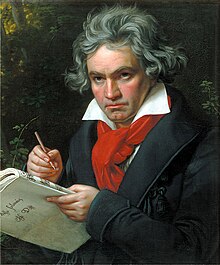
Shiho Fukada for The New York Times
Posted on 10/13/2005 4:11:50 AM PDT by Pharmboy

Shiho Fukada for The New York Times
The recently discovered manuscript for Beethoven's "Grosse Fuge."
Heather Carbo, a matter-of-fact librarian at an evangelical seminary outside Philadelphia, was cleaning out an archival cabinet one hot afternoon in July. It was a dirty and routine job. But there, on the bottom shelf, she stumbled across what may be one of the most important musicological finds in years.
It was a working manuscript score for a piano version of Beethoven's "Grosse Fuge," a monument of classical music. And it was in the composer's own hand, according to Sotheby's auction house. The 80-page manuscript in mainly brown ink - a furious scattering of notes across the page, with many changes and cross-outs, some so deep that the paper is punctured - dates from the final months of Beethoven's life.
The score had effectively disappeared from view for 115 years, apparently never examined by scholars. It goes on display today, just for the afternoon, at the school, the Palmer Theological Seminary in Wynnewood, Pa.
"It was just sitting on that shelf," Ms. Carbo said. "I was just in a state of shock."
Like Ms. Carbo, musicologists sounded stunned when read a description of the manuscript by Sotheby's, which will auction it on Dec. 1 in London. "Wow! Oh my God!" said Lewis Lockwood, a musicology professor at Harvard University and a Beethoven biographer. "This is big. This is very big."
Indeed it is.
Any manuscript showing a composer's self-editing gives invaluable insight into his working methods, and this is a particularly rich example. Such second thoughts are particularly revealing in the case of Beethoven, who, never satisfied, honed his ideas brutally - unlike, say, Mozart, who was typically able to spill out a large score in nearly finished form.
(Excerpt) Read more at nytimes.com ...
In some parts, Beethoven pays little heed to spacing out the notes in a measure, extending the five-line staves with wobbly lines in his own hand. High notes soar above the staff. The handwriting grows agitated to match the music. His clefs are ill formed. In one place, he pastes an entire half-page over a botched section with red sealing wax."
bttt

It is funny to consider that the man creating this music--crossing out parts and replacing them with others--was, at the time, DEAF AS A PLANK!
Indeed. He heard it perfectly in his head, though.
Absolutely amazing!
Cool beyond words.
He really looked like him in that getup...thanks for the memory. LOL!
Wow, I didn't even notice this was from the NYT. That's really amazing.
(steely)
Thanks!
Classical Music Ping List ping!
If you want on or off this moderate volume list, let me know via FR mail. Thanks!


Very cool!
This is exciting!
And other fancy stuff.
I understand, but it is hard to blame the old guy for Kubrick's indulgence.
He probably could still hear a little, enough to plonk something out on a keyboard.
I guess the pencil and eraser hadn't been invented them
I guess the pencil and eraser hadn't been invented then
Disclaimer: Opinions posted on Free Republic are those of the individual posters and do not necessarily represent the opinion of Free Republic or its management. All materials posted herein are protected by copyright law and the exemption for fair use of copyrighted works.